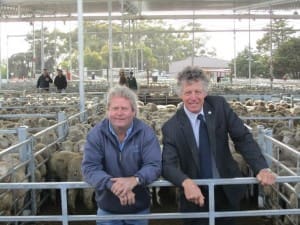
Hamilton Livestock Exchange manager Chris Dahlenburg, left, with Mirranatwa farmer Peter Dark under the saleyards roof.
VICTORIA’S state government is coming under increasing pressure to trial its proposed sheep and goat electronic identification system in a major saleyard as operators await details on the system’s implementation.
The state’s Minister for Agriculture Jaala Pulford said she has had an offer from the Hamilton Regional Livestock Exchange to trial the proposed system next year.
The Hamilton offer follows calls from national stock agent, saleyard and sheep producer bodies to hold a saleyard trial before proceeding with the EID system implementation.
After July 1, 2017, all saleyards, abattoirs and knackeries will be required to scan electronic tags of sheep and goats and upload the information to the National Livestock Identification System (NLIS) database. All sheep and goats born in the state after January 1, 2017, have to be tagged with an approved electronic identification tag before being dispatched to a saleyard, abattoir or another property. Click here to get Sheep Central story links sent to your email inbox.
Ms Pulford said her department has had some very constructive conversations with saleyard operators during the recent consultation period.
“It’s a very big and important transition and that’s why we’ve been committed to extensive consultation and that’s what we’ve been doing.”
When asked if she believed there was a need to trial EID technology in a saleyard prior to general implementation or before making infrastructural changes, Ms Pulford did not rule out or agree a trial was needed, but said the government had made the decision to change to an EID-based system for sheep and goats.
“So to anyone who wants us not to go ahead, they will be disappointed.
“I think the overwhelming majority of people accept that this change is coming and are keen to learn what it will mean for them wherever they are in the supply chain,” she said.
“We’ll provide more details in the next few weeks.”
Ms Pulford said electronic identification with low frequency technology was mandatory in the European Union and there was a lot of evidence from other jurisdictions about very large livestock sales.
“So we are confident that the technology is more than up to the task.”
Ms Pulford said Victoria was proposing to go ahead with low frequency electronic technology, despite suggestions that ultra-high radio frequency tags and equipment should be trialled.
“The evidence that supports our decision is derived from other jurisdictions and a number of studies in the UK in particular.
“The evidence we have and the advice that I have is that we can be very confident about proceeding as planned.”
Hamilton saleyard is keen to be test case
Hamilton Regional Livestock Exchange advisory committee chairman and Mirranatwa woolgrower Peter Dark said the sheep and lamb selling centre was suggested as an EID test case because stage II of a roof and yards development program was nearing completion.
“Even though the saleyard doesn’t have electronic scanning device in them, it is built so that they can be put in.
“We are saying between ourselves, Ballarat and Bendigo, we are the three biggest saleyards for sheep and lambs in Victoria and it has got to work in one of those saleyards,” he said.
“Last year, one of our Wednesday sales had 60,000 lambs in it; it has got to work on those days, otherwise it is going to fail.”
In the latest Natiuonal Livestock Reporting Service’s latest Victorian sheep saleyard survey, Hamilton maintained its ranking with the third highest throughput of 998, 439 sheep and lambs in the 12 months to June 30, 2016. Ballarat ranked highest with 1,402,315 sheep and lambs yarded, followed by Bendigo with 1,045,648.
Mr Dark said the Hamilton saleyard was designed to potentially scan sheep and lambs off trucks, as they were drafted and onto trucks for delivery to buyers.
“There could be three potential scanning sites, but we don’t know.
“The biggest comment you get at the moment is that people don’t believe that there this the equipment out there to do the job, but we still don’t know,” he said.
“Any equipment that is going to scan 60,000 lambs in one day, or 120,000 sheep and lambs over three days, has got to cope, and if it doesn’t then I believe we need to put it back until we’ve got equipment that does do it.
“I’m not saying it can’t be designed, but we just don’t know.”
Hamilton saleyard manager Chris Dahlenburg said whether it was Hamilton or Horsham, or another saleyard, the Victorian Government would be better off trialling the EID system somewhere, “rather than throwing money to everyone and just seeing if it will work.”
“They’ve invented this new game, but they haven’t given us the rules yet.
“We don’t know basically whether they want them scanned in their vendor lots and be taken off at the abattoirs, or do they want them scanned in sale lots, like we do with the cattle.
Mr Dahlenburg said he had been told the government would appoint consultants to saleyards with a scanning company to work out how it would be done and how many scanners were needed.
“And then early next year there will be funding available and we will have to submit what the consultant has told us we will need to be able to scan in the yard.
“But no-one knows at this stage how they want it done or how it is going to work,” he said.



HAVE YOUR SAY